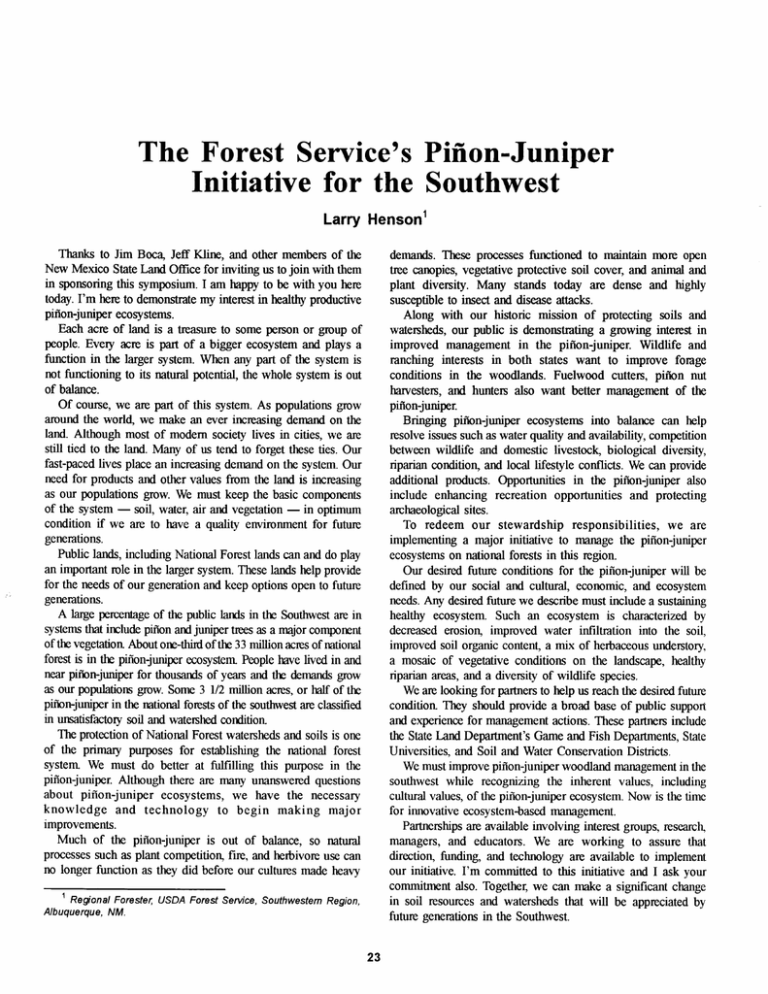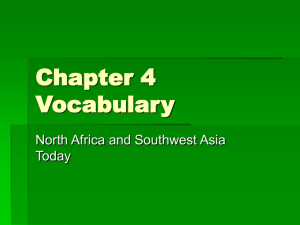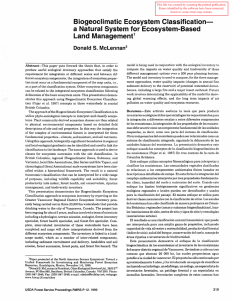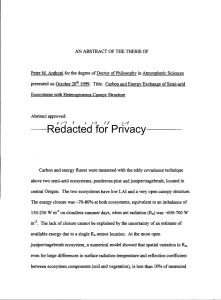The Forest Service's Piiion-Juniper ens on'
advertisement

The Forest Service's Piiion-Juniper Initiative for the Southwest Larry Thanks to Jim Boca, Jeff Kline, and other members of the New Mexico State Land for inviting us to join with them in sponsoring this symposium. I am happy to be with you here today. I'm here to demonstrate my interest in healthy productive piiion-juniper ecosystems. Each acre of land is a treasure to some peson or group of people. Every acre is part of a bigger ecosystem and plays a function in the larger system. When any part of the system is not functioning to its natural potential, the whole system is out of balance. Of course, we are part of this system. As populations grow around the world, we make an ever increasing demand on the land. Although most of modem society lives in cities, we are still tied to the land. Many of us tend to forget these ties. Our fast-paced lives place an increasing demand on the system. Our need for products and other values from the land is increasing as our populations grow. We must keep the basic components of the system - soil, water, air and vegetation - in optimum condition if we are to have a quality environment for future generations. Public lands, including National Forest lands can and do play an important role in the larger system. These lands help provide for the needs of our generation and keep options open to future generations. A large percentage of the public lands in the Southwest are in systems that include piiion and juniper trees as a major component of the vegetation About one-third of the 33 million acres of national forest is in the piiion-juniper ecosystem People have lived in and near piiion-juniper for thousands of years and the demands grow as our populations grow. Some 3 112 million a m , or half of the piiion-juniper in the national forests of the southwest are classified in unsatisfactory soil and watershed condition The pmtection of National Forest watersheds and soils is one of the primary purposes for establishing the national forest system We must do better at fdfilling this purpose in the piiion-juniper. Although there are many unanswered questions about piiion-juniper ecosystems, we have the necessary knowledge and technology to begin making major improvements. Much of the pifion-juniper is out of balance, so natural processes such as plant competition, fire, and herbivore use can no longer function as they did before our cultures made heavy ' Regional Forester. USDA Forest Service. southwestern Region, Albuquerque, NM. ens on' demands. These processes functioned to maintain more open tree canopies, vegetative protective soil cover, and animal and plant diversity. Many stands today are dense and highly susceptible to insect and disease attacks. Along with our historic mission of protecting soils and watersheds, our public is demonstmting a growing interest in improved management in the piiion-juniper. Wildlife and ranching interests in both states want to improve forage conditions in the woodlands. Fuelwood cutters, piiion nut harvesters, and huntets also want better management of the piiion-juniper. Bringing piiion-juniper ecosystems into balance can help resolve issues such as water quality and availability, competition between wildlife and domestic livestock, biological diversity, riparian condition, and local lifestyle conflicts. We can provide additional products. Opportunities in the piilon-juniper also include enhancing recreation opportunities and protecting archaeological sites. To redeem our stewardship responsibilities, we are implementing a major initiative to manage the piiion-juniper ecosystems on national forests in this region. Our desired future conditions for the pliion-juniper will be defined by our social and cultural, economic, and ecosystem needs. Any desired fhture we describe must include a sustaining healthy ecosystem. Such an ecosystem is characterized by decreased erosion, improved water infiltration into the soil, improved soil organic content, a mix of herbaceous understory, a mosaic of vegetative conditions on the landscape, healthy riparian areas, and a diversity of wildlife species. We are looking for partners to help us reach the desired future condition They should provide a broad base of public support and experience for management actions. These partners include the State Land Department's Game and Fish Departments, State Universities, and Soil and Water Conservation Districts. We must improve piiion-juniper woodland management in the southwest while recognizing the inherent values, including cultural values, of the piiion-juniper ecosystem. Now is the time for innovative ecosystem-based management. Partnerships are available involving interest groups, research, managers, and educators. We are working to assure that direction, funding, and technology are available to implement our initiative. I'm committed to this initiative and I ask your commitment also. Together, we can make a ~ i ~ c achange n t in soil resowes and watersheds that will be appreciated by future generations in the Southwest.





